SOME JENNINGS COUNTY CATHOLIC HISTORY
Compiled from various sources, including St. Mary's Centennial Booklet and Jennings County 1816 - 1999
ST. MARY'S
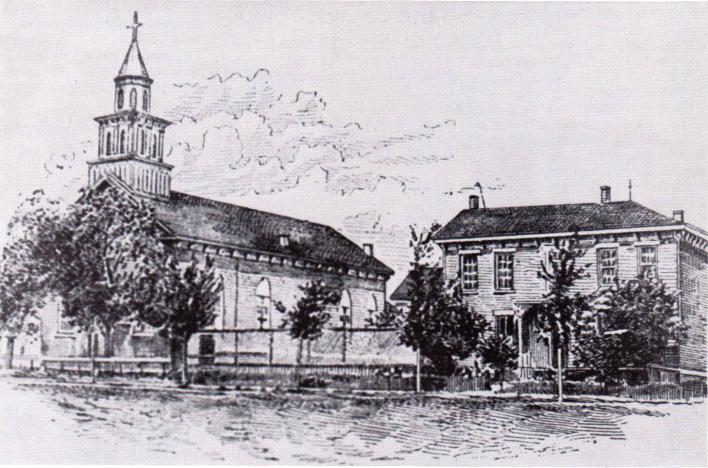
ORIGINAL CHURCH & RECTORY
From 1846 to 1856 Father Alphonse Muschina of St. Ann's celebrated the first masses in North Vernon. From 1853 until 1858 masses were celebrated in the Kilgannon home on the south side of Hoosier St. between 5th and 6th streets; also in an upstairs room of the Hemberger home, on a site afterward occupied by a main downtown hotel, near the depot. Bishop St. Palais celberated mass on one occasion, and Father Molony on another. Children were baptized on these occasions.
Rev. John M. Missi has the discinction of having spent his entire priestly career in Jennings County, so much of St. Mary's history is intertwined with his. He was born on March 13, 1833 at Waldmohr, Germany, arrived in the U.S.A July 25, 1836 at New York City on the ship Silvie de Grasse from the port of La Havre, France, and with his family settled near New Albany, Indiana. His Seminary training was received in the Diocesan College at Vincennes (1853-59), and he was there ordained priest by Bishop St. Palais on Dec. 8 1859. He was appointed pastor of St. Ann's Church on Dec. 25, 1859, residing there and attending St. Mary's as a mission for nine years. He started construction of St. Mary's Church in October 1861 but the work was interrupted by the outbreak of the Civil War when his workmen organized a company of volunteers and joined the army. This was at the time of Morgan's Raid (1863) and his work foreman was the future Major General Joe Stricker. Father Missi had the workmen wall in the north end of the church, and the building was completed after the war in 1868, the main alter was installed at that time. The church had no tower. St. Mary's was dedicated under the title "Nativity of the Blessed Virgin."
He probably built the front portion of the present brick rectory, with two rooms downstairs and two upstairs, and a stairway just inside the front door. His living quarters were in the downstairs room facing the church, with a curtain dividing his office from his bedroom. In census records his mother Catherine Missi is listed as living with him in 1860 and 1870. His father died in New Albany in 1855, his mother died March 18, 1879 in North Vernon and is buried in St. Mary's cemetery.
The rectory was heated with stoves, and there was no city water nor electric lights but there was a small cistern. He remodeled the rectory in 1886, shortly before his death.
St. Mary's Cemetery was opened in 1854, with John Rech as the first burial. It was situated about a quarter of a mile N.W. of the church on Madison Ave., near the then city limits, and comprised only one city lot. Additions were made by future pastors. In 1886, a cemetery mortuary chapel was built by Father Missi.
The original First Holy Communion class at St. Mary's was in 1864, with Father Missi coming from St. Ann's. In 1865-66, the first two-room brick school (one room a above one below)was constructed in the read of the church and somewhat to the east. Lay teachers were employed with the children of Irish desent being taught up-stairs and those of German desent down-stairs. Nicholas wolfram (brother of Theodore) were among the early lay teachers. George Nodler came from Madison, and taught at least two terms of 10 months each. His living quarters were up-stairs in the the school, and he was assisted by his sister-in-law, Miss Kyle.
School subjects were taught in both English and German, and some non-Catholics of German decent sent their children to him, until the German language began to be taught in the public school. He became a Justice of the Peace after the Sisters took over the school. James Foley, a brother of Rev. Mother M. Cleophas (St. Mary-of-the Woods), was the last lay teacher in 1870. When Father Missi was able to get the Sisters of St. Francis, from Oldenburg, in 1872, they occupied a residence on Madison Ave., across the alley the the one they occupied later, which had been donated by Mrs. Winters. This residence was later sold, and the proceeds used to construct the mortuary chapel at the cemetery. Sister M. Oliva (later Rev. Mother Olivia)was one of the early teachers.
Soon after Father Missi came to North Vernon, he organized an Alter Society, which was later divided into two groups, with the Germans in St. Mary's Society and the Irish in St. Bridget's Society.
He was appointed Rural Dean in 1886. After almsot 30 years of devoted service and unsparing work in Jennings county and vicinity, his great heart began to fail and he was confined to his bed in the rectory. Fater August Sennefeld came to assist him with the parish work, in August 1889, and remained for five months. Father Missi went to his final reward on Dec. 3, 1889, and his death marked the end of an era in the parish. Obituary of Father Missi.
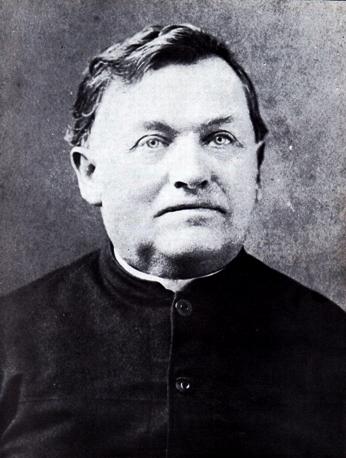
Father John Michael Missi
The three years and three months which followed Father Missi's death were difficult times for the parish. Nothing is recorded except for baptismal records.
Rev. George L.T. Widerin was transferred from North Madison to North Vernon on Apr. 3, 1893, when he took over the pastorate. He was born on July 20, 1847 in Louisville, Ky. and moved to New Albany at the age of four. He was a member of Company A. 144th. Ind. Infantry during the Civil War. (144th Ind. Infantry - Organized at Indianapolis, Ind., and mustered in March 6, 1865. Left State for Harper's Ferry, W. Va., March 9. Attached to 1st Brigade, 2nd Provisional Division, Army of the Shenandoah. Duty at Halltown, Charleston, Winchester, Stevenson's Depot and Opequan Creek till August. Mustered out August 5, 1865.) He completed his seminary course at St. Meinrad (1872-77) and was ordained a priest on May 28l 1877. He was pastor of St. Mary's Church, North Vernon until his death on Feb. 3, 1920.
Coming to North Vernon, Father Widerin kept his council and went to work. Gradually he reconciled the factions in the parish and put the people to work. He used every resource to finance the parish, stiring rivalry among the parish societies for better results. He always kept the high respect of the community, and his patriotism was enhanced by his war record. This was evidenced during the Ku Klux Klan activity, in 1919 when he erected a lofty flag pole and unfurled a huge American flag, on the school grounds. At that time the church was heated by two stove, and it had no tower nor stained glass windows. One of his first enterprises was to have the water mains extended to the church property. Then he put stained glass windows in the church, and added the statue of the Sacred Heart of Mary. The Madison Ave. (now Second St.) was rocked and graveled by volunteer parish labor. Church and Rectory roofs were repaired, during the following year and an iron fence erected on parish property. Church fairs were held each fall to supplement the parish revenues. The parish was soon a going concern. School was conducted in the 2-room building in the church yard, with 100 to 115 pupils in attendance. Steady improvement of the property continued during the following years, with the church interior decorated, and new floors laid, and circular windows added in the sanctuary, and some new statuary and a pipe organ installed in 1902. The cemetery (rear portion) was graded and an iron fence erected, in 1904, and an addition built on the rectory.
The Y.M.I. (Young Mens Institute) was organized in the parish, in 1902, and supplanted by Knights of Colubus in 1912.
The Church Tower
This landmark of the parish and community was erected in 1897. Records indicate that the parishoners hauled 60,000 bricks and 75 wagon loads of sand for its construction by J.B. Miller. After the work had started, the non-Catholics joined with the Catholics and sent a delegation to Father Widerin, requesting that a clock be installed. This necessitated an addition of 20 ft. to the height of the tower and changed the planned proportion. The subsequent tornado in 1917 demonstrated the solidity of the structure. A subscription by citizens and parishoners was taken up to defray the cost, which was about $4,000.00. At this time, Father Widerin discarded the old bells and installed a fine peal of bells, purchased from Stuckstede of St. Louis, at a cost of about #800.00. The large bell weighs 1548 lbs., the medium bell 826 lbs., and the small one 504 lbs. The Seth Thomas tower clock cost $600.00 and has given wonderful service through its 64 years.
The Parish School
This was Father Widerin's outstanding achievement. The building site was purchased in 1905, blueprints drawn in 1906 by Bohlen & Sons of Indianapolis, and a parish subscription taken up in 1907. The stone foundation was laid by Mike Kirchner, and the remainder of the building constructed by J.B. Miller. This building is remarkable for its solidarity and its general adaptablilty to later changes, and it seems to have been constructed for a total cost of $17,000.00. Boiler and steam radiation were installed by Harry Hicks. The plumbing was primative by present standards, and much of the interior necessarily remained unfinished until the debt was reduced, but these details were added later. One marvels at Father Widerin's success in this project. Three classrooms were started in the new school. Quite a celebration was held on the day of its dedication, June 21, 1908, by Bishop Dennis O'Donaghue. As a final touch shade trees were planted in the school yard. This debt was finally paid in 1915.
Further Improvements
In 1911, an upper story was added to the Sisters' residence, a hot water heating system installed in the rectory, and the communion rail and set of Stations placed in the church. In 1912, two lots were purchased on Clay St., adjoining the church property, and a residence erected for the parish custodian. That same year, he constructed a private sewer, connecting all the buildings on parish property, and emptying into the city sewer on Second St. This sewer continues to function. Also, a hot air furnace was installed in the church, and all buildings equipped with lightning rods. Beautiful onyx candle sticks were purchased for the altars, in 1914, and altar lights installed. School desks were purchased for the class rooms, and a room built for use of the Sisiters.
The Bell Tolls Again
Father Widerin's health began to decline. The number of souls in the parish had lessened somewhat from the higher figures of the previous years. Father seemed to have had a premonition that the parish burden would soon be shifted to other shoulders, and he made a final payment of $1,600.00 on the parish debt. At the end of 1918 there was a sinking fund of some $3,000.00. Meanwhile, Father Meirad Rouck had arrived in May, fresh from ordination, to assist him with the operation of the parish. As the end drew closer, Dr. Dennis McAuliffe made frequent calls at the rectory. Again, it was a big heart beating out at the end of a long life of dedication and sacrafice. He died in the rectory on Feb. 3, 1920, and was interred in St. Mary's Cemetery.
His death was a big loss for the parish and community. He was a man of few words, austere but kind. He would never have been able to accomplish so much during his lifetime without hard work and system. He combined a native caution with good business judgement. He was universally respected and loved, especially by the children, who sensed his sterling qualities and unswerving justice. For many years, the businessmen of the town had made regular contributions for his annual Christmas gift. His pastorate was a blessing to St. Mary's Parish.
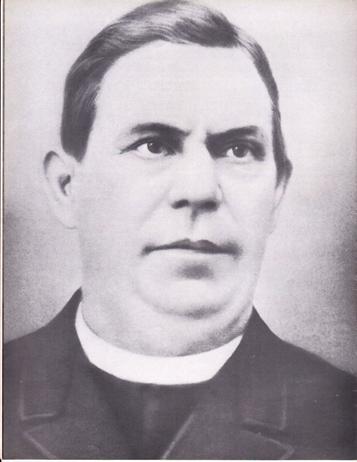
Rev. George L.T. Widerin
The Busy Assistant
Rev. Mienrad Rouck was born on March 5, 1887, near New Albany and ordained on April 24, 1918 at St. Mienrad. During Father Rouck's months in the parish, the first virulent outbreak of the influenza epidemic occurred in the parish. and parish and community forces were organized to meet the emergency. A private hospital was set up and manned by volunteer labor and Father and his untiring helpers earned the admiration of all by their devoted works of charity to the 27 patients in their care. Father Rouck administered the parish until the new pastor arrived.
The Fisher of Men

Father Sprigler soon consolidated some of the parish activities. Gradually he eliminated the money raising enterprises of the numerous parish societies. He abolished payment of tuition by pupils in the parish school, and made it a free school supported by the entire parish. He was encouraged and notably assisted in these moves by Henry Miller. The old school, near the church, was removed. Assessments were paid in April 1921, for a new sewer on Second Street. The cemetery was enlarged by its second edition, Lot No. 6, which extended it to the city limits, as then established. The services of Joe Horstman were enlisted as parish custodian, in April 1923, and he continued in this capacity, with respect and appreciation of the entire parish, until his death in 1946. Father Sprigler was a good financier and left a substantial balance in the parish treasury.
Father Sprigler's early years were much occupied in countering the obnoxious activities of the Ku-Klux Clan, which was then in ascendancy. For this purpose, he used the oratorical ability of Father Pierce Dixon, who had been appointed pastor of st. Joseph Church, at Four Corners, in 1924, Father Sprigler was the guiding genius in selecting strategic spots in the County for Father Dixon's lectures to public audiences and determining the topics of his talks. He insured a plentiful distribution of free literature at these meetings. Large assemblies were addressed at the Court House in Vernon and in various scattered localities. Bigotry was exposed and disarmed very effectively, and a foundation laid for the good community relations of the present day. So effectively was the work done, that Harry Meloy, an eminent non-Catholic in the community, was elected city mayor on a anti-Klan ticket. Mr. Meloy embraced the Catholic faith during his final illness, and was buried from St. Mary's Church, in 1934.
The parish was saddened by the news of Father Sprigler's change to Evansville, in June 1934. They bade him farewell with heave hearts, as they wished him "God Speed" in his new charge.
ST. ANN's
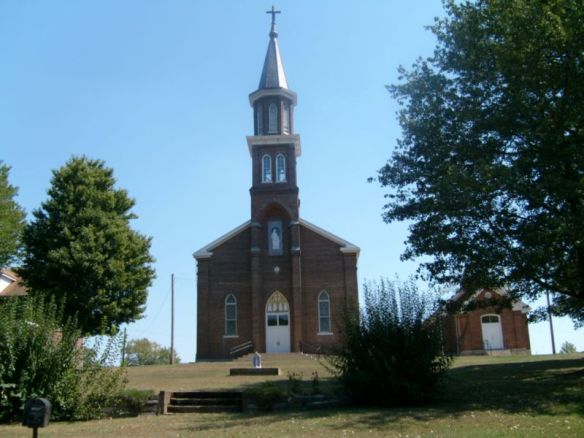
Photo taken 2008 by Sheila Kell
St. Ann's has been the most difficult to find a history on. The one below was in a file, as an undated clipping from a newspaper. I am following it with some
newsclippings and a transcription of some of the early church documents we have at the Jennings County Public Library
It was probably in the year 1840 that a Roman Catholic congregation was established here. It was then called the "New Settlement on the Greensburg Road", and was composed of about fifty-nine German and Irish families. They had been attracted by the fairness and apparent fertility of the soil. They were, more or less, such people as were employed in the construction of the Madison railroad. From the very earliest up to the present time, but few Protestants have lived in this district, the only one of whom there seems any recollection is Mr. Beech, who settled here about 1832. Before 1830, the settlers were John and Joseph Gasper, Joseph Erbsland, Simon Blaes, Frank Hilderict, Tony Frederick, John Heil and a Mr. Sterling; in 1830-35, John Decker, George Decker, John Henry, Bias, Specht and Adam Dittlinger. After this, among the earliest settlers, -though the date of settlement could not be ascertained, - were Nicholas Demmer, Antone Daeger, Antone Gasper, Mr. Winter, Mr. Friesz, Jacob Johennes, Mr. Gantner, Mr. Gehl, Mr. Klein, Gasper and Michael Burkert and George Mayer.
As above stated this settlement was first called the "New Settlement on the Greensburg Road" later it was called, and often at present, "The church at Gray's Branch, or Long Branch." But the present name of location is "St. Ann's". The land about here is fertile on the streams. The flats are very good for wheat. The principle products of the farmers are corn, wheat and oats. A good deal of stock is raised. Up to the year of 1830, no horses and few wagons were in this part of the country. Oxen and home-made carts were used.
When Claude Mick settled here, in 1850, he found about seventy families; some from Bavaria, Prussia, Baden, Alsace Lorraine, etc. They had a log church some forty feet long, twenty four feet wide, and twelve rounds of logs high. Formerly they had congregated in a room, attached to the old parsonage which has since been torn down, and replaced by the new house on the north side. At present the congregation has a fine brick church-spacious enough-having three alters, a fine pulpit, confessional and a choir. The house on the county road to Long Branch, one fourth mile south of the Catholic church, now occupied by Mr. Phillip Mick (Phillip Mick died in 1906 which helps with dating this history), was built in 1832, as a district school house, and was used at the same time as a Baptist meeting-house. The first teacher seems to have been Mr. Sterling, who had been compelled to leave France on account of having taken part in the "Robespierre Revolution", which put Louis XVI to the guillotine. Mr. S. is said to be a well educated man. This school was attended by many of the present settlers, a few of whom remember to have had an Irish teacher, who received one cent per day from every child, and free board from the settlers, he staying with one family one day and with another family the next day. Now this man loved whisky so much that he compelled his scholars to bring their cents every day, in order that he could get his whisky. The present school teacher is Mr. John Bapt. Schuster, a well educated and agreeable gentleman. In 1850 the house was sold to Mr. C. Mick, and the money obtained was divided-a school-house being built a few yards south of John Stott's farm, on this same road, and another house for school purposes, near the Catholic church, which is now occupied by the teacher as a dwelling house, it having been repaired and fitted up for such purpose.
Concerning the pioneer life of the settlers, it has been that, like to most every backwoodsman who settles in a forest where the sound of the axe has not as yet been heard. A few of them - Mr. Simon Blaes and Mr. George Decker-remember to have seen Indians and conversed with them. That is to say, they did not camp here anywhere, but would now and then show their faces, being on the hunt for game. At that time (1830) they were plenty of wild turkey and deer in this neighborhood. George Decker and Joseph Clem managed to kill nineteen head in one day. From the many traces and things left by the Indians it is very apparent that this part of the county was one of their favorite resorts. About the year 1852, Jos. Gasper plowed up forty-five tomahawks near the roots of an old poplar stump, just east of the Catholic church. They were very heavy. He left them lying on the stump but when others heard of them and found they were so heavy, they supposed there was gold or silver in them and broke them into pieces, except one which is still preserved by Rev. L. Oosterling. There are also several caves that were used by the Indians along the Muscatatuck one on the east side of the road to Oakdale and another about eight miles farther north.
Clipping from the Vernon Banner - May 17, 1866
Catholic ChurchOn Tuesday, May 2st, (Phillips and Jacob's day) the corner stone of a new brick church was lain at Longbranch. We are told that Father Brand of Madison, and Father Stoltz of Six Mile were present assisting in the ceremonies. The congregation at Longbranch are determined to build a splendid church. Their Priest Rev. J.M. Missi is an energetic gentleman, and will push the matter forward with his usual perseverance.
Clipping from the North Vernon Plain Dealer - February 15, 1877
Father Oesterling;On Friday morning, 9th inst., Father Oesterling died and on Monday, in accordance with an expressed wish in his first sermon in the church, he was buried in front of St. Mary's altar in St. Ann's church, on Long Branch, in the presence of a host of friends. For many years he had been in charge of the church above named, and was beloved by all his church people. In his intercourse with persons holding opposite religious opinions he was always the polite and courteous gentleman. He interested himself with little outside of his profession, and was a friend to everybody.
Clipping from the Plain Dealer - May 19, 1910
St. Ann Parsonage Burned to Ground.Last Thursday afternoon a flue in the Catholic parsonage, occupied by Father Ginnz, pastor at St. Ann, was noticed to be buring out; neighbors went over to see that no damage was done and before leaving locked very closely to see if the fly had caught anything on the inside of the house, but everything seemed to be alright. On Friday morning about four o'clock the dwelling was in flames; almost all the contents were saved. Message was sent to this city for assistanc; several automobiles, a number of firemen with extinguishers were rushed to the scend and arrived in time to see those gallant farmers saving a shed that stood within ten feet of the house that was burned. There was no insurance on the building.
Transcriptions of record beginning in 1841
This Register to make entries of the Baptisims, Marriages & Burials that are to be performed hence forward in this new Settlement on Greensburg Road, comprising Two hundred forty seven folios,
has been by me Pastor of this St. Ann's Church, quoted and signed from the first to the last folio, for a better warranty.
Madison 1st February 1841 ? Chartier1841 Baptisms
March 21st I Etienne (Stephen)Chartier Pastor of this Church have this day baptized Catherine born 9th December last of the lawful marriage of Michael Clarkin & Rosa Clarkin the sponsors have been Matheis Kahow & judith Caine.
23rd Baptised Patrick born to-day lawful son of John & Mary Buckley Sponsors Patrick & Helen Buckley
" " Baptized Edward lawful son Edward & Mary M David born 28 February last. Sponsors John Buckley & Allice M Grath
" " (Cannot read this entry) April 27th Baptised Charles lawful son of Charles & Margarita Gaspar born 27 March last. Sponsors Joseph Gaspar & Christiana Speckt
" " Baptised Elisa lawful daughter of George & Elizabeth Langborn 16th instant Sponsors Joseph Danser & Elisa Blaise
June 6th Baptised Honor lawful daughter of Patrick & Mary Wils Sponsors William Wils & Catherine Noon (born 26th April last.)
" " Baptised Ann lawful daughter of William & Elizabeth Wils born 4th instant - Sponsors Daniel Sheerin & Helen Welch
July 5th Baptised Caroline lawful daughter of Leonard & Margaret Vilgis born 13th June last Sponsors Rev. Etienne Chartier & Margaret Rush
August 29th Baptised John lawful son of Nicholas & Catherine Winter born on 4 instant, Sponsors John Gaspar & Nicholas Deinmer & Catherine Winter
" " Baptised Lewis lawful son John & Clarabell Hembergar born 5th July last, Sponsors Adam Deimerhild & Barbara Beach.
" " Baptised Johanna lawful daughter of Leonard & Helena Whegan? born 8 July last Sponsors Joseph & Barbara Beach
" " Baptised Charles lawful son of James & Hellen McQuay born 13th instant Sponsors Edward Murphy & Hellen Fitz Gibbon
December 10th Baptised Mary Scandlen daughter of Anthony and ____ Scandlen born 10 November Sponsors John Calvin and Maria Calven
ST. JOSEPH'S
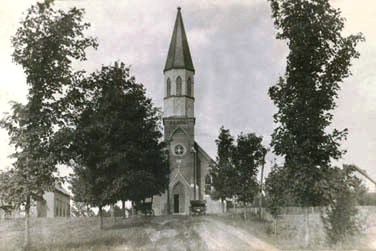
Much of the information below copied from what was the St. Joseph Catholic Church web page, that page no longer exists.
A HISTORY OF ST. JOSEPH CATHOLIC CHURCH
Preface: To compile the following historical narrative, it was necessary to rely on church lore handed down verbally.
Accounts written earlier seem to take much the same approach. The chronology of priests and land costs come from church and public records. In 1821 John and
Adam Sheets received the first land deed to a part of Section 15 in Spencer Township. It was in this same section that a settlement known as Buena Vista, or
Four Corners, would grow. Between 1835 and 1839 many other deeds were granted in the area to families whose names denote an Irish origin. These settlers, along
with an influx of German settlers, became the foundation for what was to become St. Joseph's parish.It was then called St. Catherine's Parrish as it was beginning to decline, Buena Vista was beginning to prosper. The parish of St. James, which would become St. Joseph's, was officially established in 1850 with the first church being built. The first priest was Father Munschina. Jacob and Elizabeth Cline sold the property for $1.00. As the cross roads, now known as Four Corners rather than Buena Vista, a thriving community existed. On the northeast corner was St. James church, rectory, and cemetery. Directly across, on the northwest corner, was a school, general store, dance hall, and saloon. On the remaining corners were a blacksmith shop and a residence, but conflict exists as to which structure was on which corner. By the mid 1860's, it was felt that the cemetery used for St. James would soon be filled. Land records show that in 1866" for The Sum of fourteen Hundred (sic) and fifty Dollars to be paid by the St. Jacobs (Latin for James) congregation (sic) of Bunavista" forty acres (with the exception of a square half acre) was purchased from Henry and Chatrina Young. It appears that by 1871 a two-acre site had been laid off for the new cemetery and lots sold. Tombstones in the cemetery actually date from 1869.
In the early 1890's, Reverend Gillig started the idea of building a new church on the acreage purchased in 1866. Reverend Joseph Thie began plans for building the church and soon construction began. Foundation stones were quarried from John Barrier's property. During the winter months, the stones were brought down on horse drawn sleds. Brick also had to be hauled. A crew was hired and Mrs. John (Frances) Elsner fed them. Construction proceeded and on May 7, 1892 Bishop Chatard laid the cornerstone. In October of 1892, Bishop Chatard returned and dedicated the new church St. Joseph's. Much of the work and materials were donated. The new church cost $6,400. Louis Richart, Joseph Mang, and Susanna Weitzel donated the altars. Those whose names still appear on them donated the stained glass windows. Phillip Speckner donated the lumber for the wooden benches that were sawed out of native lumber. The Riordon estate donated the original front doors. Since the building of the new church, there have been many changes to the property. Under the direction of Reverend John Schueth there was a school built between the years of 1906 and 1913. After this there was a school for the parish children every spring.
Within the next few years, during the time Father Henry Hunger was here, a new rectory was built. Father Hunger lived in the school house until the new rectory was finished. The rectory cost $2,800, and as in the past, the parishioners donated a lot of the material and work. Reverend Omer Eisman became pastor in 1920. He paid off the debt and installed moderm conveniences in the rectory. The most notable change in the appearance of the church came in the late 1930's. The steeple was in need of repair and had begun to leak. One popular belief is that a tornado passed over and blew down a part of the steeple. Workers were hired to tear down and rebuild a new structure. That steeple is what we see today. As stated previously, of the forty acres, there was a half-acre square not included. On this property was what was known as the "old brick hall". At one time it was known to have been a store and dance hall. It was a two-story structure and was the site of many dances on the first floor and card parties on the second. It was donated to the church by the John Nicklaus estate in 1924. Because of needed repair, it was decided in 1940 to build a new building to replace the "old brick hall." The "new" hall built in 1940 was built just a few feet from the schoolhouse. It is said that there was just enough room to walk between the two buildings. In the 1960's the schoolhouse was torn down. About the same time, under the direction of Father Ed Eisenmann the church pews we now have were purchased.
The last major renovation in the church building took place in the late 1960's and early 1970's under the direction of Father James Dede. The old altars and Stations of the Cross were replaced. The old oak doors were replaced around this time. The church took on a new look. In the mid-1990's talk of replacing the parish hall was beginning. In 2001-2002 a new hall was built and dedicated on the site of the old hall. Many activities centered on the church are fondly remembered. The picnic grove has been the site of many reunions. Before World War ll, there were the big Labor Day picnics. There were fundraisers; there were chicken dinners and contests such as turtle races and bowling. Around Thanksgiving there was a shooting contest for turkeys. These activities usually concluded with a square dance. These were often held on an outdoor platform set up for the occasions.
Over the years many priests have served St. Joseph's Church. They are listed as follows:
Fr. Alphonsus Munschina(October 1851 - January 1854)
Fr. Edward Martin (Martinovic) from Madison (January 1854 - March 1854)
Fr. Peter Kruesch (March 1854 - April 1856)
Fr. Bernard H. Schultes (Attending from St. Ann's)(April 1856 November 1859)
Fr. Phil Doyle, the first resident pastor (November 1859 - October 13, 1862)
Fr. John Stolz (October 1862 - March 1871)
Fr. Michael Merz (March 1871 - May 1873)
Fr. Bernard H. Kintrup (June 1873 - July 1875)
Mission attended by Fr. John Missa and Fr. Anthony Schenk (July 1875 - May 1876)
Fr. Francis X. Seegmueller (May 7, 1876 - August 1877)
Fr. James Pfeiffer (August 1877 - February 1882)
Fr. Celestine Schwarz (June 1882 - February 1887)
Fr. Francis Nuehoffer (February 1887 - April 1890)
Fr. Matthew A. Gillig (April 1890 - February 1891)
Fr. Joseph Thie (February 1891 - July 1901)
Fr. John Loibl (July 1901 - July 1906)
Fr. John Schueth (July 1906 - June 1913)
Fr. Henry Hunger (June 1913 - July 1920)
Fr. Omer Eisenmann (July 1920 - July 1924)
Fr. Pierce Dixon (July 1924 - June 1927)
Fr. Edward Eisenmann (July 1927 - December 1929)
Fr. Mathias Schmitz (December 1929 - July 1934)
Fr. Louis Becher (July 1934 - July 1935)
Fr. Raymond Marchino (July 1935 - September 1940)
Fr. Joseph Laugel (September 1940 - May 1943)
Fr. Cyril Conen (May 1943 - October 1948)
Fr. Edward Eisenmann (October 1948 - August 1966)
Fr. James Dede (August 1966 - July 1973)
Fr. James Arneson (July 1973 - 1994)
Fr. James Meade (1994 - 1996)
Fr. Paul Etienne (1996 - 1998)
Fr. Joseph Moriarty (1998 - 1999)
Fr. Joseph Brown CPPS (1999 - 2003)
Fr. C. Ryan McCarthy (sacramental minister 2003 installed as pastor in 2004)
Fr. Bill Keebler, Administrator June 2006
Fr. Jonathan P. Meyer, Administrator July 2008 installed as pastor February 2009
Fr. Jerry Byrd (March, 2014 - Installed as Pastor)
ST. DENIS CHURCH
No longer active but the church building still exists
Information on this church from a booklet published for their Centennial Celebration on August 14, 1994 compiled by Alice Chandler - this booklet
was donated to the Jennings County Public Library as part of the research of Anabelle Pickett.
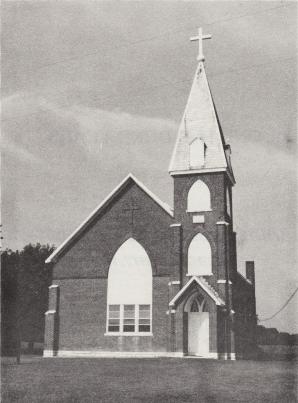
Photo taken 1992
The history of St. Denis Church is a very interesting one, beginning with its formation in the late 19th century. In February of 1894,
approximately ten acres of land was donated for the church by local residents Thomas, Emma, and Mary Woods in the name of the late Denis Woods. In gratitude for
this generous gift, the parish chose the name Saint Denis.The founder of St. Denis was the Reverend Matthias Gillig. After his father's death in Germany in 1854, his mother brought her three sons to the United States. All three men became Catholic priests, with Matthias being ordained May 17, 1874. He was first sent to Mt. Vernon, Indiana, and then became pastor of St. Nicholas, Ripley County, Indiana, where he built the school in 1881. He then assisted his brother John, pastor at Millhousen, Indiana, until founding St. Denis in 1894.
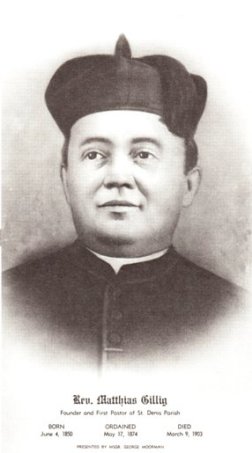
Father Matthias Gillig
When Father Gillig celebrated St. Denis' first mass, the altar boy was George Moorman. He eventually went on to become Monsignor George
Moorman, of the Fort Wayne Diocese in Indiana. It is said that Fr. Gillig would leave St. Denis for short periods of time, returning with his pockets full of money
to donate to the church. Father Matthias Gillig celebrated his Silver Jubilee at St. Denis in 1899. He died of pneumonia on March 09, 1903, and was laid to rest in
the church's cemetery.The first church building was a 12 foot by 20 foot sawmill house, donated by the John Woods family. This family was one of St. Denis' ten or so founding families, and was related to the family of Denis Woods that donated the land. The sawmill house was dragged by a team of workhorses to a site about one city block south of where the present church stands, on the south side of a small cemetery. It was used for services while the present brick church was under construction. In late 1894 when the church was completed, the sawmill house was removed, and that area became the St. Denis Cemetery.
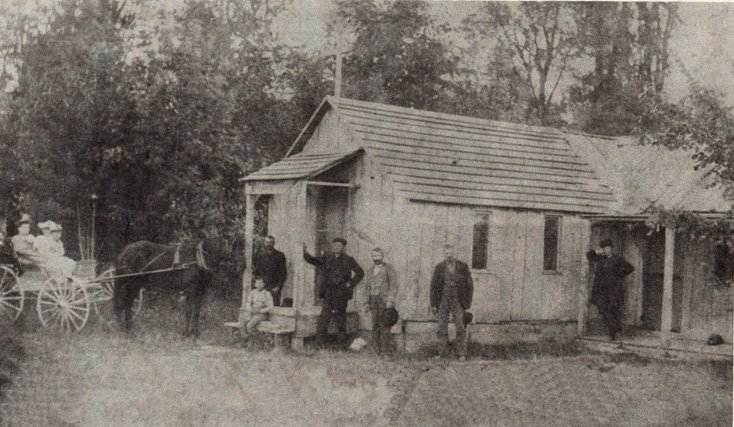
The original sawmill house used as the church - Father Gillig is at the far right leaning on the post.
The architect for the church and the rectory was Mr. Theodore Schneider of Millhousen. The donations of both material and labor were very generous, with parishioners funding the entire project. Wood for the pews and beams was hewn from native timber, and the foundation of the church was formed using rocks taken from local creek beds. Each brick was hand made from clay dug on the property. Financial reports show that in 1904, parishioner donations were collected for the construction of a church steeple. It was erected in 1905, under the direction of Father James Delaney.
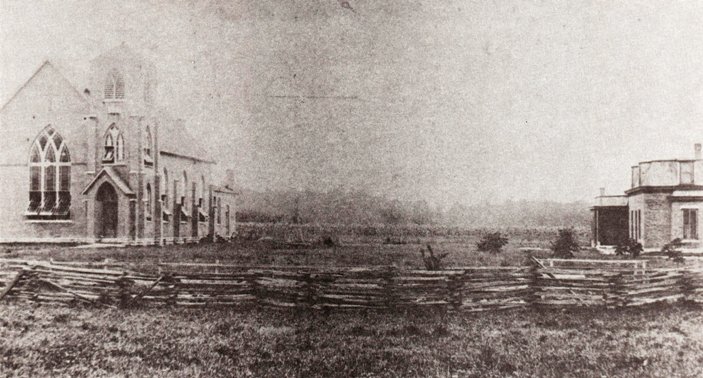
St. Denis prior to the addition of the steeple.
The rectory was built in 1900 and stood for 87 years. It was a frame brick building, on the north side of the present church. St. Denis had four
resident pastors, all of whom lived in the rectory between the years of 1900 and 1916. After Fr. Gillig, the next two resident pastors were Father John Barthel and Father
James Delaney. Then in 1907, under the direction of resident pastor Father William P. Garrity, a wood frame addition was added to the west side of the brick rectory. It
is said that while the addition was under construction, Fr. Garrity slept in the belfry of the church steeple. Fr. Garrity was St. Denis' last resident pastor, and he lived
at the rectory from 1907 to 1916. For the next seven decades, the building was rented to tenant, then used for meeting, schooling, and as a social hall. In 1987, the building
was burned as a training exercise for local fire-fighters.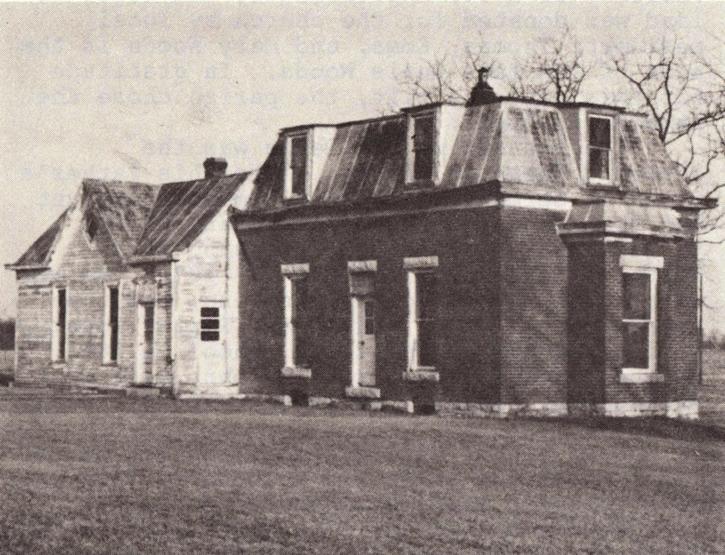
St. Denis Rectory and Parish Hall - picture taken on St. Patrick's Day - shortly before it was destroyed.
From 1894 to 1903, three lay teachers taught school at St. Denis. This was a parochial school, and the teachers were paid by the parish. Their school room was the long room in back of, and part of, the present church. In 1994 the room was still being used for gatherings and church meetings, as well as bible study and religious classes.
In 1980, Monsignor Joseph Brokhage was appointed as administrator of St. Denis, along with the churches of Immaculate Conception at Millhousen, and St. Maurice at Napoleon. Monsignor Raymond Bolser, although not officially assigned, willingly joined him to help out on weekends, and the majority of masses at St. Denis were celebrated by Msgr. Bosler. The mass schedule was changed, giving St. Denis a 4:00PM mass each Saturday. That schedule was kept through 1994.
In 1981, Miss Rita Knueven was hired as Pastoral Associate for St. Denis and Immaculate Conception. Msgr. Brokhage helped St. Denis to form its first parish council that year, and parishioners became involved as lectors and eucharistic ministers.
Planning for a major church renovation was begun at St. Denis in 1982. It was a parishioners project, they donated as much time and labor as possible. In 1983, the roof of the church was replaced. Between 1983 and 1986, all new windows were installed. A new furnace was purchased in 1984. In 1987, the steeple was purchased in 1984. In 1987, the steeple was repaired and the statues were repainted. Between 1988 and 1989, the steeple was repaired and the statues were repainted, all pews and woodwork were refinished, and carpeting was installed throughout. Parishioner Bernard Pfeifer made and donated the large wooden cross that now hangs above the altar. Later, the bricks on the exterior of the church were tuckpointed and sealed.
In 1987, Rita Knueven left the position of Pastoral Associate, and Sister Carol Leveque, SC was hired as Pastoral Associate and Director of Religious Education. Msgr. Brokhage and Masgr. Bosler continued serving the St. Denis, Immaculate Conception, and St. Maurice parishes on weekends. Each celebrated his Golden Jubilee with the community. All three parishes helped in a Golden Jubilee celebration for Msgr. Bolser on July 31, 1988, and one for Msgr. Brokhage on April 16, 1989.
In 1991, Msgr. Brokhage retired from his position as administrator. Sr. Carol Leveque was appointed by Archbishop Edward T. O'Meara as Parish Life Coordinator for St. Denis, Immaculate Conception, and St. Maurice. This was only the third such appointment made in the Archdiocese of Indianapolis. There was an installation ceremony and reception for Sr. Carol on October 20, 1991. She continued this position, fulfilling a three year term and serving through August of 1994.
During 1991 Msgr. Brokhage and Msgr. Bosler continued to celebrate weekend masses until a replacemnt for themselves could be found. In 1992, Father Joseph Rautenberg was appointed as Priest Minister for St. Denis, as well as Immaculate Conception and St. Maurice. He continued this position, coming to the parishes on weekends while serving full time during the week as ethicist at St. Vincent's Hospital in Indianapolis.
St. Denis was proud to take credit for having one of its native sons called to the priesthood. Father Francis Diekhoff was ordained May 26, 1920. He celebrated his first mass May 30, 1920 at St. Bartholomew Church in Columbus, Indiana. His first appointment was to St. Philip Neri Parish in Indianapolis in July of 1927. He was then given the care of Holy Angels Church in Indianapolis in July of 1927. On November 5, 1927 he was taken to St. Vincent's Hospital in Indianapolis, suffering from pneumonia. He died on November 11, 1927 and his funeral mass was held at Holy Angels.
St. Denis had several traditions throughout its heritage. One early tradition that parishioners used to follow determined where folks were seated in the church. Children sat with their parentss until they received their First Holy Communion, around the age of six or seven. They were then allowed to sit in the front pews of the church, boys on one side and girls on the other. Later, the boys became altar servers and the girls moved to the back of the church to sing with the choir. After graduation from high school, the boys moved up into the balcony and remained there until they married, then moved back into the main body of the church.
In church grounds were maintained by local parishioners. Originally, the grass was cut only a couple of times a year when the men of the church would gather and cut it with scythes. They also had a get-together each needed for the winter. According to some older parishioners, all of the families met once each year during the late summer for a day-long picnic and harvest celebration in the woods behind the church.
Another tradition concerns the cemetery and graves. When a parishioner of St. Denis died, the men of the parish met at the cemetery and dug the grave by hand using shovels. The women prepare a funeral meal for visiting friends and relatives. Two elderly sisters, Anna and Clara Schneider, were parishioners in the early years of the church. When they died they left all of the money they had to the St. Denis Cemetery for upkeep and burials. The church and cemetery each had an endowment, both given by a devoted member of the parish.
St Denis also received a memorial donation from another of its early members. In 1928 when parishioner Ellen C. Carder died, she willed her 125 acre farm to St. Denis Church. Trustees of the chruch at that time were Ben J. Diekhoff, Matt Woods, Maurice Hahn, and Clement Schwering. For several years, the house and farm ground were rented to tenants. Then, in 1939 while Fr. Joseph Laugel was pastor, the farm was sold.
One of the things that makes St. Denis Church unique is that there has never been a town or village of any kind here. The church was the focal point of the community. St. Denis Church was built and supported by, its parishioners, its clergy, and its friends.

Arial photo of the Church and Rectory taken Fall 1983
CHURCHES NO LONGER IN EXISTANCE
ST. CATHERINE'S CHURCH was situated about 4 miles S.W. of North Vernon, on two acres of ground, on the ridge in the Indian Creek neighborhood. The parish of St. Catherine's (nicknamed "The Little Irish Church")
was the first Catholic parish in the area. It was established in 1841 in the Indian Creek neighborhood which was about three miles east of Buena Vista.
By 1843 the parish numbered approximately twenty Irish and seven German families. Parish development was probably hindered by Irish-German
friction, as, by 1871, the parish no longer existed. The cemetery, though, still remains. Link to St. Catherine's Cemetery.
The first log church (40ft. x 25ft.) was built in 1841,under the supervision of Father Chartier from Madison. There were 20 Irish and 7 German families in the congregation in 1843. In 1846 Rev.
Daniel Maloney paid the congregation regular visits once a month. This structure was replaced by a frame church (50ft. x 30ft.), in 1849, with construction probably directed by Father Maloney from Columbus.Transcription of Early Records by S. Kell
Very difficult to read spelling is the best I can make out.
1841 Copy from St Cath Church Jennings Co. Ind. Per G. Widerin A.D. 1912Baptism's
Jany 10 Anthony Hake son of John & Barbara Hake born Dec. 19, 1840 Sponsors Antonius Hake & Eva Hake, Wm. Charier Pr.
Jany 10 Adam son of Nicklas & Susan Wahl born Jany 6, 1841 Sponsors John & Christina Wagner, Wm. Charier Pr.
Feb. 11 Mary Josephine daughter of George & Mary Rickert born March 19, 1840 Sponsors Joseph & Barbara Hunt, Wm Chartier Pr.
Feb. 11 Juliana parents Joseph & Barbara Hunt born Sept. 28, 1839 Sponsors George & Mary Rickert, Wm. Chartier Pr.
March 17 Margaret daughter of Thomas & Catherine Purcell born Feb. 23, 1841 Sponsors James Duffy & Catherine McGuenty Wm. Chartier pastor
July 7 Michael son of John & Barbara Reinhart born April 28, 1841, Sponsors Nicklas & Susan Wahl Wm. Chartier pastor.
Oct 5 William son of John & Melissa Bolton born Dec. 29, 1840 Sponsors Mary Ann & Sophia Bean Wm. Chartier pastor.
Oct. 6 James son of James & Bridget Welsh born Sept 26, 1841, Sponsors John M & Ann McAdams Wm. Chartier pastor
Aug. 24 Bridget daug. of William & Bridget Moore, born July 26, 1841 Sponsors Michael McAndrews & Hellen Sherin Wm Chartier pr
Aug. 24 Thomas son Patrick & Bridget Lehey born February 1841 Sponsers - David Merrick & Margaret Dush? Wm. Chartier Aug. 24 Catharine daug. Of John & Christina Wagner born July 17, 1841 Sponsors Peter Cook & Catharine Spitznagle Wm. Chartier pastor
Aug. 25 Special Notice
Aug. 26, 1841 I the undersigned pastor of this congregation, have given the nuptial benediction according to the Rites of the Catholic Church to David Merrick & Mary McManemney already civily married in presence of Daniel Strarin, Wm Moore & Michael McAndrews Wm Chartier pastor
1842
March 3 John son Jacob & Anna Maria Hake Sponsers - John Kocharin & Barbara Hake
April 20 Elizabeth-dau- Nicholas Wall & Suzanne Wall Sponsers - John Wolsifer & Elizabeth Wolsifer
Aug 22 Judith Juliana - dau- Thomas & Brigitte McLaughlin Sponsers - Amtpmois Kane - Brigitta Moore
Aug 26 Thomas-son- Thomas & Sara McManidy brn Aug 31, 1942
Synopsis of total receipts for building Sts Catherine & Bridgets' church collected by Rev. D. Molony Pastor, Right Rev. M __ H. Palais Bishop - John Wagner & Jas Walsh trustees up to 15th Nov. 1849 in cash, bills, labor Received from the Irish resident in Parish $189.50 Recd, from Irish at Scipio, Endinburgh, Wabash, Madison, Jeffersonville & Columbus R. Road $159.50 Received from Germans - in cash $14 in bills $50 = 64.00 Recd. From Americans in & near Vernon in cash $16. In Sundries 17 = 33.00 total $446.00 Paid Sundies as per Receipts & accounts the above Sum Danl. Molony Pastor Received in total from the Irish for this church $349 of which sum $192.50 was giv by me from strangers for whom a memento will be made in memory that God may bless an protect the Donors.
The following persons & their heirs are entitled to the burial ground attached to their names at St. Catherine's in Jennings Co. Indiana, on 4th April 1847 Rev. D. Malony Pastor presiding and Messers __ Razore & John Waggoner being trustees the following regulations were made viz
1. That all Strangers coming to the Settlement after this date & not having contributed to the building of the Church or making the cemm shall pay for burial ground from 3 to 5 dollars according to their means - when poor to be admitted free.
2. That the head of each family owning a lot shall erect a head board or stone to the memory of the deceased in order to designate his lot.
3. That no grave be raised more than six inches over the level that the Superflous clay be thrown on the walk.
4. That the moneys so received shall be kept by said trustees jointly for the repairs of the present church or the building of a new one.
N.B. The first plot in South next the fence - the 2nd adjacent & ___ the 1st lot is east farthest from the Church the others counted ____
1st plot N. Wall 15 Peter Donnell 14 Pat McCaffry 12 John Noon 11 Campbell 9 George Houk 8 Thos McGinty 5
Jas Kelly 4 Corrigan 3 Jas McCaffry
2nd plot B. Haly 7 Phil Rielly 6 Leon Philips 5 John Houk 4 Pat Lahy 3 M Moore 2 Wm Walsh 1
3rd plot McQuade 15 Jno McManny 14 W Burk 12 Rich Isarte 11 Jas Kane 9 Jho Knight 8 Jno Reynhart John Reynhart 6 Henry Razor 5
Jennings 1
4th plot John Philips 15 McManamy 13 Anthony Hauk 10 Pat Richart 5 Thos Jordan 4
The old (frame) Irish Church was destroyed on the 10th of June 1883 by a Cyclone. The Irish settlers had either moved or lie in the cemetery mentioned above. It was not necessary to rebuild. There were a few burials on the Sacred hill after services were abandoned. A devotee and his son - John Wrape, father, Henry Wrape the son, built a little Memorial Chappel on the now desolate spot.
This mission was attended at various stages of its existence by neighboring priests. It ceased to function in 1871, 30 years after its establishment, and the members affiliated with St. Mary's at North Vernon or with St. James' (now St. Joseph's) at Four Corners (established in 1850).
ST. PATRICK'S CHURCH, SCIPIO was also built in 1841, and church services began in 1842. In the beginning, it was attended by priests from Madison. The 1844 Catholic Directory listed Father Roman Weinzoepfel as pastor. Services were suspended at the Mission on March 20, 1958, after the congregation had practically become extinct. Its survival as a mission for 116 years constitutes a rather unique record. Through the years, mass was always celebrated each month on the third Sunday. The frame church was remodeled in 1916. In 1975 the church building was torn down. Today the small cemetery Link to St. Patrick Cemetery. remains and the old church bell marks the burial place of Father Daniel Malony, near where the door of the church had stood. This placing of the bell as a memorial was done by Fr. Henry Brown when he was pastor of St. Mary's in North Vernon. Born in Ireland in 1803, Fr. Daniel Molony completed his studies for the priesthood in Paris and in his native land, and was ordained priest at Vincennes, in 1845, by Bishop Hailandiere, after teaching at Maynooth University for 14 years. He died in retirement, in 1874, on the former Ella Haley homestead near Queensville. He served in many parishes of the diocese, and impressed them with his priestly zeal. He was one of the stalwart pioneer priests of our diocese.
ST. BRIDGET'S CHURCH, a frame building, stood near the eastern limit of the village of Nebraska, just south of Highway 50. It was erected in 1867 on ground acquired by Bishop St. Palais, probably to service the numerous families of Irish descent who settled in that neighborhood during the construction of the Baltimore and Ohio Branch Line, from North Vernon to Louisville. It was attended by Fr. Missi (1868-88) from North Vernon. until shortly before his death. Services were discontinued at this mission, about 1930. The church was removed and the ground sold on March 18, 1936. This mission had numbered some 60 families in 1883, but there were scarcely any survivors when it closed after an existence of 60 years. Any members remaining would have likely joined either St. Ann's or St. Mary's.
You may use this material for your own personal research, however it may not be used for commercial publications without express written consent of the contributor, INGenWeb, and